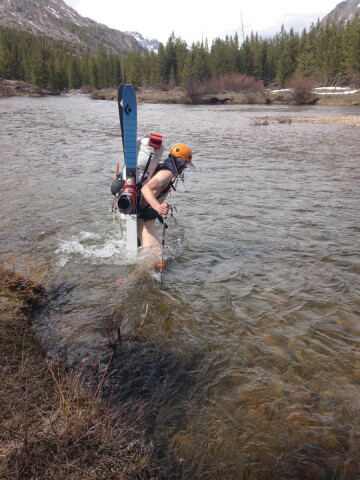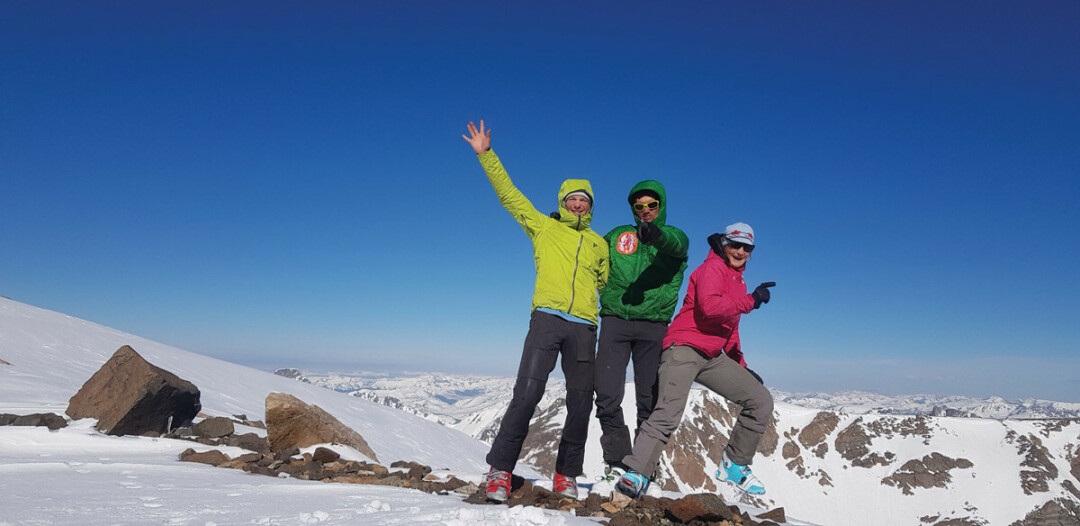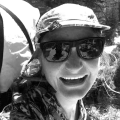Epic Adventure In The Backyard From Livingston To Red Lodge By Ski
Ruby Zitzer | Friday Jan. 1st, 2021

Three a.m. on May 7: Bars back in Bozeman have been closed for an hour. Drunk people are still stumbling home. We stand on a rock ledge that is dry and free of snow, a comforting rarity, small pleasures at 10,000 feet. We can look out across the large Montana valleys toward the close tender glow of Bozeman, which lays about 40 miles away. Moonlight ignites the frozen land around us, the world glows silver. Too early to talk or think too hard. Sawyer Kesselheim, my 25-year-old brother, packs his backpack, stooped over, shoving things in place. Everett Coba, my partner, 22 years old, serves up breakfast, savory oats. We chug them down in silence, fueling the fires, each of us pondering the day ahead, keeping our worries private.
Terrain in the Absaroka Mountains is rugged and in-your-face; the beauty is both breath taking and fearsome. Never more so than with Black Peak looming in the moonlight overhead and prospects of a questionable route. At promptly 4 a.m., we set out on a partially frozen, moonlit snowpack by headlamp, skinning up a steep, big tube toward Black Peak above Pine Creek Lake. This is Plan B. Our original route, created on Caltopo and Google Earth from the comfort of a couch two weeks prior to departure, turned out to be impossible. The day before, we were confronted by a 35-45-degree couloir which looked good from the comfort of the coach during the planning phase, but in reality, it would have popped us out on a saddle NE of the summit. On the edge of a sheer cliff.
Orange and purple erupt in the sky behind Sawyer. The sun slowly ignites the tips of mountains, and we pause to appreciate it, our heavy breathing the only sound. Our hope is that at the top of Black Peak, we will find a wide ridge which looks promising on our Gaia map. If it goes, we’ll promptly get back on our planned course. If it doesn’t, we will have spent a lot of energy only to face Plan C, whatever that is. I focus on our goal, that hopeful ridgeline. The tube is steep and firm, our ski crampons claw into the snow with their metal prongs. We all rely heavily on that metal grip, balancing and trusting it, but it is a constant tension. Every step requires focus. My legs burn from two days of hard skinning over passes and through basins, navigating tough terrain while carrying a 65-pound pack. We inch upward toward the dark peak, each of us deep in our personal calculations, or just breathing. Dawn fires up the sky when we make it out of the tube. To reach the peak, we have to drop down and boot up a wide, steep couloir.
I sink waist deep, carrying skis on top of my pack, ice axe in hand, struggling to keep up with my tall, long-legged companions. Head down, I work my legs through the snow following Sawyer and Everett’s deep boot holes. We touch the summit as the wings of the sun spread. The vast, raw range unfolds before us, the views dazzling. Everything drops away, even my aching legs, in the face of this beauty.
I turn to look at the route ahead. Dread and fear seep into my gut. The east ridge is not so much a ramp as an 80-foot cliff. We can see our route, a tantalizing 200 yards away, over a sheer drop and dangerously out of reach. Unwilling to surrender, we search for routes onto the ridgeline. We scramble with skis and heavy packs over icy loose rocks. Each of us denies the growing certainty of turning back. We have worked too hard to get here. It has to go. Sawyer and Everett probe methodically, meticulously, pushing for an opening. Desire threatens good judgment. We all know that our expedition hangs in the balance.
In the midst of all this, I am ambushed by the thoughts of our dear friend Dee Dee. Dee Dee passed away due to a hospital mistake just a week before we left. It was a sudden jarring death for our family, community and for her partner. Being in the ICU when she passed was a very real reminder of how fragile life is. She has been with me a lot on this trip, riding along in my thoughts, her ring on my finger keeping her close. But then I snap out of it, watching two other people I love dearly take risks in order to get back on a route we had created looking at a computer screen.
“Guys, this is not worth it! It’s too dangerous. Let’s go back to the summit and re-evaluate.” They both look back at me, at each other, and turn. We retreat.
Back on the summit, we have cell service. I pull out my phone to call home. After the first two rings my dad picks up. He and my mother have been intently following our progress. Each message we send in the evening from our SOS device gives them our location. This device allows us to contact the outside world by text and has an SOS button in case of an emergency.
His voice fills me with warm comfort. We relay our current situation, where we are and that we are off route, but to not worry. Most important we remind them how much we love them. It’s only after I hang up that the loneliness of our situation swoops back in. I look at my two partners, forcing down the urge to burst into tears. Still, we don’t talk much. There isn’t anything to discuss. We turn together, defeated, and start back down.
Our descent takes us down the iconic Y couloir, a fall line pushing 50 degrees. Fear quickens my breathing. We stand on top, doing our best to not over think the danger. Everett drops in first, ice axe in his upper hand. Conditions are firm, not quite ice but on the verge. He slowly makes his way down, side slipping most of it, tucking into safety about 500 feet below. Sawyer goes next, talking to me as he descends with confidence, encouraging me. My turn comes quickly. Legs shaking, I focus on breathing. Slowly, I make my way sliding down the firm snow, time ticking, everything else fading away, just the icy chute, my clattering skis, the two dots of life watching me come. Out of my peripheral vision, I notice the car-sized overhanging cornice dripping water. The day is heating up quickly. With it, the growing danger of unstable avalanche conditions.
Finally, I make it to the small nook of safety. I sit down and begin to cry, my legs cramping from exertion, my heart heavy with defeat, our camp from the night before just below us and our expedition in doubt.
Our route was an ambitious one, simple in concept but daunting in practice. Basically, we planned to ski from the outskirts of Livingston to the outskirts of Red Lodge, across the Absaroka and Beartooth Mountains. I had dreamed of doing it for a long time.
We started skinning at the Elephant Head trail, which sits on the northern flank of the Absaroka Mountains near Livingston. The Absaroka’s are a fierce mountain range, bordering Yellowstone Park and the upper Yellowstone River, blending seamlessly into the high peaks and plateaus of the Beartooth Range. These mountains, chock full of grizzly bear, mountain lion, wolf, marmots and other creatures are mostly viewed by people from the comfort of Paradise Valley or from scenic pullouts along area highways.
The route would take us beyond the Absarokas, across the Boulder River and into the Bearthooth Mountains. We would ford the rushing Stillwater River and traverse the Beartooth Plateau to Red Lodge, the bookend town on the eastern edge of the range. We would ski past Granite Peak, Montana’s highest, looming over other Montana summits at 12,807 ft.
We hoped to stay as high as possible, following ridgelines and crossing passes, taking advantage of the best skiing, while keeping in mind the overarching goal of safety. The beauty of winter travel is that you aren’t bound to the boot prints on the man-made trails. The thin red line we mapped out was approximately 115 miles in length, includes 60,000 feet of elevation gain, and was our best effort to create an aesthetic route that traversed jagged, weather-beaten mountains with good skiing, exciting route finding and adventure. In many ways, it rivaled mountaineering expeditions in Alaska or Patagonia but it lay barely 50 miles from home and our entire journey would only cost us a few hundred dollars.
But now, Pine Creek imprisons us in its palm.
After the trip, I spoke to my father about his concerns following the Black Peak phone call.
“For me it was a really high anxiety moment. I guess that’s the high and low of having contact. I wasn’t sure how you were going to move forward,” he told me. “Sometimes too much information can be dangerous. In a sense, ignorance is bliss.” 
We camp again in Pine Creek just above our previous site. Over dinner we talk about our only option to escape and rejoin our route. The following morning, my 23rd birthday, we wake earlier than normal, hoping to leave Pine Creek Basin via a steep saddle at the northeast end. We quickly gain elevation, but to our disappointment we discover an unstable, isothermic snow pack, too dangerous for us to continue. We stand in the light of our headlamps, the future of our ski traverse grim. After several minutes of picking through our dwindling options, we start skinning up a slightly lower angle slope, scattered with thin snow and rock. We keep up a methodical rhythm between rock patches and snow, inching toward the distant ridgeline. No one speaks. I realize that for long stretches I’m holding my breath. The only sound is the swoosh of our skis and the scraping of metal edges against rock. No one wants to jinx this route. Finally, we gain the ridge and whoop in triumph. The morning is lit with orange and yellow, made more welcome by our success and the escape from the clutches of Pine Creek.
Sawyer pulls out a colorful shirt, “Your birthday shirt!” he exclaims. I pull it over my head, the bright yellows, oranges and reds aglow against the white landscape. I couldn’t have asked for a better gift.
The Absaroka Range is named after the Absaroka Indians. The name is derived from a Hidatsa name for the Crow people, which means “children of the large-beaked bird.” That morning we felt as though we had been liberated by “the children of the large beaked bird.”
Pine Creek set the tone for the trip. The route, the weather and the challenges of the landscape kept us on our toes and kept throwing formidable obstacles in our way. We knew that the ridge on the next horizon, the stream crossing in the next valley, the deadfall on a steep bushwhack or waking up to poor weather could stop us in our tracks. At the same time, we skied through phenomenal basins that reminded us of our insignificance. We set out on this ski traverse with expectations of living in and experiencing the mountains so close to home, but often so distant and out of reach.
Four days later, we had our first food drop. My parents met us at Fourmile Creek on the Boulder River. It was a warm, glorious day. While we waited, we pulled out all our wet gear on a sand bar; it looked like an explosion of nylon and color. A few hours later, our resupply arrived, full of rotisserie chickens, salads, jerky, kombucha, beer and pie. With my parents came Beans, our three-legged, 14-year-old dog, there for emotional support and quality ear scratches. The food filled the picnic table, a proper feast. Between mouthfuls we shared stories, relieved to have someone from the outside world to talk to, relishing that small dose of normality.
Spring time is perfect for a ski traverse in every way except raging river crossings. Mountaineering history is full of misadventures on stream crossings. At four in the afternoon, ten days in, we reached the Stillwater River. We were high up on the drainage, but it was still a wide, strong flow separating us from the high country of the Beartooths. Determined to cross before camping, we stripped out of our clothes, strapped and crammed our bulging backpacks and stepped into the icy current. Using our poles for balance, we moved slowly, water rushing around us, coming up to our waists in the deepest parts. If we lost our balance, our 65-pound packs had a high potential for drowning us, or at least taking us for a long hypothermic swim. Once across safely, we gave each other satisfying high-fives before pulling on layers and collecting wood to build a fire.
The traverse from Livingston to Red Lodge took us 15 days. I have a highlight reel in my mind of the dawn ascent up the shoulder of Granite Peak, the bluebird day skiing across the Beartooth Plateau at 10,000 feet, the porcupine in the tree next to our campsite, days full of companionship and solidarity as our team gelled. It seems as though every time I go out to see films about the outdoors, they feature a far-off place like Patagonia or Pakistan or deep in Alaska. They show people getting “gnarly” and pushing the limits with huge expectations, taking life-threatening risks, spending thousands of dollars and assuming complicated logistics. I get pulled in by the adrenaline rush, the challenges, but then I ask myself, why do I live in Bozeman? One of the most powerful reasons is the outdoor opportunities all around me. And yet, so many people feel that epic adventures require them to fly to another continent and spend a year’s salary.
For us it was different. We didn’t try to get sponsored. We didn’t create a route that followed social trends. We didn’t spend thousands of dollars to travel across the world to an iconic mountain range. Instead, we looked around us to find beauty and adventure. We set out on our skis to traverse and experience the mountains of home. For a time, we lived there, letting that landscape embrace us. At no point did we discuss trying to traverse as quickly as possible, conquer first ascents, or ski the most epic lines. We wanted to achieve the route with competence and respect, while maintaining safety. In the end, it was one of the most physically and mentally demanding adventures I have ever taken on. And one of the most rewarding.
| Tweet |
